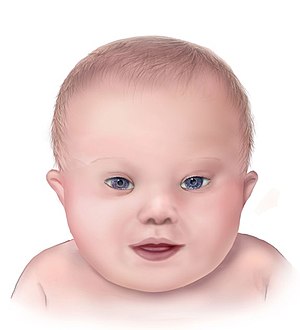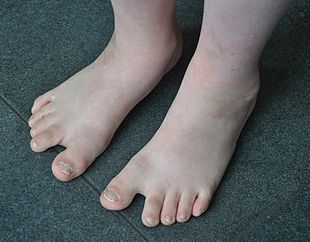唐氏综合症:修订间差异
小 →癌症: 增加或调整参考来源 标签:2017年版源代码编辑 |
→非血癌: 新章节 标签:2017年版源代码编辑 |
||
| 第137行: | 第137行: | ||
在唐氏综合征中,AMKL 通常先于短暂性骨髓增殖性疾病 (TMD),这是一种血细胞生成障碍,其中 GATA1 基因突变的非癌性巨核细胞在妊娠后期迅速分裂。<ref name="sciencedirect2" /><ref>{{Cite journal |last=Tamblyn |first=J. A. |last2=Norton |first2=A. |last3=Spurgeon |first3=L. |last4=Donovan |first4=V. |last5=Bedford Russell |first5=A. |last6=Bonnici |first6=J. |last7=Perkins |first7=K. |last8=Vyas |first8=P. |last9=Roberts |first9=I. |last10=Kilby |first10=M. D. |date=2016-01 |title=Prenatal therapy in transient abnormal myelopoiesis: a systematic review |url=https://fn.bmj.com/content/101/1/67 |journal=Archives of Disease in Childhood. Fetal and Neonatal Edition |volume=101 |issue=1 |doi=10.1136/archdischild-2014-308004 |issn=1468-2052 |pmid=25956670}}</ref>3-10%的唐氏婴儿受到影响。<ref name="sciencedirect2" />虽然它通常在出生后三个月内自发消退,但它会导致严重的血液、肝脏或其他并发症。<ref name="wiley5">{{Cite journal |last=Gamis |first=Alan S. |last2=Smith |first2=Franklin O. |date=2012-11 |title=Transient myeloproliferative disorder in children with Down syndrome: clarity to this enigmatic disorder |url=https://onlinelibrary.wiley.com/doi/10.1111/bjh.12041 |journal=British Journal of Haematology |volume=159 |issue=3 |doi=10.1111/bjh.12041 |issn=1365-2141 |pmid=22966823}}</ref>在大约10%的病例中,TMD在其解决后的三个月至五年内进展为 AMKL。<ref name="sciencedirect2" /><ref name="wiley5" /><ref>{{Cite journal |last=Bhatnagar |first=Neha |last2=Nizery |first2=Laure |last3=Tunstall |first3=Oliver |last4=Vyas |first4=Paresh |last5=Roberts |first5=Irene |date=2016-10 |title=Transient Abnormal Myelopoiesis and AML in Down Syndrome: an Update |url=https://link.springer.com/article/10.1007/s11899-016-0338-x |journal=Current Hematologic Malignancy Reports |volume=11 |issue=5 |doi=10.1007/s11899-016-0338-x |issn=1558-822X |pmc=5031718 |pmid=27510823}}</ref> |
在唐氏综合征中,AMKL 通常先于短暂性骨髓增殖性疾病 (TMD),这是一种血细胞生成障碍,其中 GATA1 基因突变的非癌性巨核细胞在妊娠后期迅速分裂。<ref name="sciencedirect2" /><ref>{{Cite journal |last=Tamblyn |first=J. A. |last2=Norton |first2=A. |last3=Spurgeon |first3=L. |last4=Donovan |first4=V. |last5=Bedford Russell |first5=A. |last6=Bonnici |first6=J. |last7=Perkins |first7=K. |last8=Vyas |first8=P. |last9=Roberts |first9=I. |last10=Kilby |first10=M. D. |date=2016-01 |title=Prenatal therapy in transient abnormal myelopoiesis: a systematic review |url=https://fn.bmj.com/content/101/1/67 |journal=Archives of Disease in Childhood. Fetal and Neonatal Edition |volume=101 |issue=1 |doi=10.1136/archdischild-2014-308004 |issn=1468-2052 |pmid=25956670}}</ref>3-10%的唐氏婴儿受到影响。<ref name="sciencedirect2" />虽然它通常在出生后三个月内自发消退,但它会导致严重的血液、肝脏或其他并发症。<ref name="wiley5">{{Cite journal |last=Gamis |first=Alan S. |last2=Smith |first2=Franklin O. |date=2012-11 |title=Transient myeloproliferative disorder in children with Down syndrome: clarity to this enigmatic disorder |url=https://onlinelibrary.wiley.com/doi/10.1111/bjh.12041 |journal=British Journal of Haematology |volume=159 |issue=3 |doi=10.1111/bjh.12041 |issn=1365-2141 |pmid=22966823}}</ref>在大约10%的病例中,TMD在其解决后的三个月至五年内进展为 AMKL。<ref name="sciencedirect2" /><ref name="wiley5" /><ref>{{Cite journal |last=Bhatnagar |first=Neha |last2=Nizery |first2=Laure |last3=Tunstall |first3=Oliver |last4=Vyas |first4=Paresh |last5=Roberts |first5=Irene |date=2016-10 |title=Transient Abnormal Myelopoiesis and AML in Down Syndrome: an Update |url=https://link.springer.com/article/10.1007/s11899-016-0338-x |journal=Current Hematologic Malignancy Reports |volume=11 |issue=5 |doi=10.1007/s11899-016-0338-x |issn=1558-822X |pmc=5031718 |pmid=27510823}}</ref> |
||
==== 非血癌 ==== |
|||
患有唐氏综合症的人患所有主要实体癌的风险较低,包括肺癌、乳腺癌和宫颈癌,其中50岁或以上的人的相对发病率最低。<ref name="mdpi" />这种低风险被认为是由于21号染色体上存在的肿瘤抑制基因的表达增加。<ref name="mdpi" /><ref>{{Cite book|chapter=Cancer genome and tumor microenvironment|url=https://www.worldcat.org/oclc/574748442|publisher=Springer|date=2010|location=New York|isbn=978-1-4419-0711-0|oclc=574748442|first=Andrei|last=Thomas-Tikhonenko}}</ref>睾丸生殖细胞癌是例外,它在唐氏综合症中的发病率较高。<ref name="mdpi" /> |
|||
== 流行病学 == |
== 流行病学 == |
||
2022年6月22日 (三) 04:05的版本
| 唐氏综合症 | |
|---|---|
| 同义词 | 21三体综合症 |
 | |
| 唐氏综合症的五官图解 | |
| 症状 | 身体发育迟缓、特征性面部特征、轻度至中度智力障碍 |
| 常見始發於 | 出生前 |
| 病程 | 终生 |
| 类型 | 染色体疾病[*]、染色體三倍體症、total autosomal trisomy[*]、疾病 |
| 肇因 | 21号染色体的第三个拷贝 |
| 风险因子 | 母亲年龄较大,先前受影响的孩子 |
| 診斷方法 | 产前筛查,基因检测 |
| 治療 | 教育支持,庇护工作环境 |
| 预后 | 预期寿命50至60岁(发达国家) |
| 盛行率 | 540万 (0.1%) |
| 分类和外部资源 | |
| 醫學專科 | 医学遗传学,儿科学 |
| ICD-11 | LD40.0 |
| ICD-9-CM | 758.0 |
| OMIM | 190685 |
| DiseasesDB | 3898 |
| MedlinePlus | 000997 |
| eMedicine | 943216 |
| Orphanet | 870 |
唐氏综合症(英語:Down syndrome、Doen's syndrome)也称为21三体综合征,是一种由21号染色体的全部或部分第三个拷贝的存在引起的遗传性疾病。[1]通常与身体发育迟缓、轻度至中度智力障碍和特征性面部特征有关。[2]患有唐氏综合症的年轻人的平均智商为50,相当于一个8岁或9岁儿童的心智能力,但差异很大。[3][4]
受影响个体的父母通常遗传正常。[5]概率从20岁母亲的不到0.1%增加到45岁母亲的3%。[6]额外的染色体被认为是偶然发生的,没有已知的行为活动或环境因素会改变这种可能性。[7]唐氏综合症可以在怀孕期间通过产前筛查然后进行诊断测试来识别,或者在出生后通过直接观察和基因测试来识别。[8]自从引入筛查以来,唐氏综合症的妊娠通常会被终止。[9][10]
唐氏综合症无法治愈。[11]教育和适当的护理已被证明可以提高生活质量。[12]一些患有唐氏综合症的儿童在典型的学校课程中接受教育,而另一些则需要更专业的教育。[13]一些患有唐氏综合症的人从高中毕业,还有一些人接受了高等教育。[14]在成年期,美国约有20%的人以某种身份从事有偿工作,[15]其中许多人需要有庇护的工作环境。[13]通常需要在财务和法律事务方面的支持。[16]在有适当医疗保健的发达国家,预期寿命约为50至60岁。[3][16]建议定期筛查唐氏综合症中常见的健康问题。[3]
唐氏综合症是人类最常见的染色体异常之一。[3]每年出生的婴儿中约有千分之一发生。[1]2015年,全球有540万人患有唐氏综合症,27,000人死亡,低于1990年的43,000人。[17][18][19]唐氏综合症以英国医生约翰·兰登·唐的名字命名,他在1866年充分描述了这种综合征。[20]法国精神病学家让-艾蒂安·多米尼克·埃斯基罗尔(Jean-Étienne Dominique Esquirol)在 1838 年和法国医生爱德华·塞金在 1844 年对这种情况的某些方面进行了较早的描述。[21]唐氏综合症的遗传原因于1959年被发现。[20]
体征和症状




患有唐氏综合症的人几乎总是有身体和智力残疾。[22]作为成年人,他们的心智能力通常与 8 岁或 9 岁儿童相似。[3]他们通常还具有较差的免疫功能,[5]并且通常在较晚的年龄达到发育里程碑。他们患许多其他健康问题的风险增加,包括先天性心脏病、癫痫、白血病、甲状腺疾病和精神障碍。[20]
| 特征 | 百分比 | 特征 | 百分比 |
|---|---|---|---|
| 精神障碍 | 99%[23] | 牙齿异常 | 60%[24] |
| 生长发育迟缓 | 90%[25] | 斜眼 | 60%[5] |
| 脐疝 | 90%[26] | 手短 | 60%[24] |
| 颈后皮肤增加 | 80%[20] | 短颈 | 60%[24] |
| 肌张力低 | 80%[27] | 阻塞型睡眠呼吸暂停 | 60%[20] |
| 嘴顶狭窄 | 76%[24] | 小指尖弯曲 | 57%[5] |
| 扁头 | 75%[5] | 虹膜布鲁什菲尔德斑 | 56%[5] |
| 韧带柔韧 | 75%[5] | 断掌 | 53%[5] |
| 成比例地大舌头[28] | 75%[27] | 凸舌 | 47%[24] |
| 外耳异常 | 70%[20] | 先天性心脏病 | 40%[24] |
| 鼻子扁平 | 68%[5] | 斜视 | ≈35%[2] |
| 第一和第二脚趾分开 | 68%[24] | 隐睾 | 20%[29] |
身体
患有唐氏综合症的人可能具有以下部分或全部身体特征:下巴小、眼睛倾斜、肌肉张力差、鼻梁扁平、手掌有一条折痕,以及由于嘴巴小而舌头相对较大而导致舌头突出。[27][28]气道变化导致大约一半的唐氏综合症患者出现阻塞性睡眠呼吸暂停。[20]其他常见的特征包括:扁平而宽的脸、短的脖子、过度的关节灵活性、大脚趾和第二脚趾之间的额外空间、指尖上的异常图案和短手指。[24][27]约20%的人会出现寰枢关节的不稳定性,并可能导致1-2%的脊髓损伤。[3][16]多达三分之一的唐氏综合症患者可能会在没有创伤的情况下发生髋关节脱位。[20]身高增长较慢,导致成年人往往身材矮小——男性的平均身高为 154 厘米(5 英尺 1 英寸),女性为 142 厘米(4 英尺 8 英寸)。[30]随着年龄的增长,患有唐氏综合症的人患肥胖症的风险增加。[20]生长图表是专门为患有唐氏综合症的儿童开发的。[20]
神经
唐氏综合症导致大约三分之一的智力残疾病例。[5]许多发育里程碑被延迟,爬行能力通常发生在8个月左右而不是5个月左右,独立行走的能力通常发生在21个月左右而不是14个月左右。[31]
大多数患有唐氏综合症的人有轻度(智商:50-69)或中度(智商:35-50)智力障碍,有些人有严重(智商:20-35)困难。[2][32]患有嵌合型唐氏综合症唐氏综合症的人的智商分数通常比这高10-30分。[33]随着年龄的增长,唐氏综合症患者的表现通常比同龄人差。[32][34]
通常,患有唐氏综合症的人对语言的理解比说话的能力更好。[20][32]10%到45%的人或口吃,或说话快速且不规则,难以理解。[35]到了30岁以后,有些人可能会失去说话的能力。[3]
他们通常在社交技能方面做得很好。[20]行为问题通常不像其他与智力残疾相关的综合征那样严重。[32]在患有唐氏综合症的儿童中,近30%发生精神疾病,5-10%发生自闭症。[16]患有唐氏综合症的人会经历各种各样的情绪。[36]虽然患有唐氏综合症的人通常很快乐,[37]但抑郁和焦虑的症状可能会在成年早期出现。[3]
患有唐氏综合症的儿童和成人癫痫发作的风险增加,这种情况发生在5-10%的儿童和高达50%的成人中。[3]这包括增加称为婴儿痉挛的特定类型癫痫发作的风险。[20]许多(15%)活了40年或更长时间的人会患上阿尔茨海默病。[38]年满60岁的人中,50-70%的人患有这种疾病。[39]
感官
超过一半的唐氏综合症患者会出现听力和视力障碍。[20]视力问题发生在38%到80%的患者上。[2]20%到50%的人患有斜视,两只眼睛不会一起移动。[2]白内障(眼睛晶状体混浊)发生率为 15%,[16]并且可能在出生时出现。[2]圆锥角膜(一种薄的锥形角膜)[3]和青光眼(眼压升高)也更常见,[2]需要佩戴眼镜或隐形眼镜的屈光不正也是如此。[3]38%至85%的个体存在布鲁什菲尔德斑(虹膜外部的白色或灰色/棕色小斑点)。[2]
50-90%的唐氏综合症儿童存在听力问题。[40]通常是50%至70%发生渗出的中耳炎[16]和40%至60%发生慢性耳部感染的结果。[41]耳部感染通常始于出生后的第一年,部分原因是咽鼓管功能不佳。[42][43]由于外耳道阻塞,过多的耳垢也会导致听力损失。[3]即使是轻微程度的听力损失也会对言语、语言理解和学业产生负面影响。[2][43]重要的是排除听力损失是社交和认知恶化的一个因素。[44]与年龄相关的感觉神经型听力损失发生在更早的年龄,并影响10-70%的唐氏综合症患者。[3]
心脏
唐氏综合症新生儿的先天性心脏病发病率约为 40%。[24]在心脏病患者中,约80%有房室间隔缺损或室间隔缺损,前者更为常见。[3]随着人们年龄的增长,二尖瓣问题变得普遍,即使是那些出生时没有心脏问题的人。[3]其他可能出现的问题包括法洛四联症和动脉导管未闭。[42]患有唐氏综合症的人动脉硬化的风险较低。[3]
癌症
虽然唐氏综合症的总体癌症风险没有改变,[45]但睾丸癌和某些血癌的风险增加,包括急性淋巴细胞白血病 (ALL) 和急性巨核细胞白血病 (AMKL),而其他非血癌的风险降低 。[3]据信患有唐氏综合症的人患生殖细胞癌症的风险增加,无论这些癌症是血液相关还是非血液相关。[46]
血癌
白血病在唐氏综合症儿童中的发病率高出10到15倍。[20]尤其是急性淋巴细胞白血病(ALL)的发病率高出20倍,而急性巨核细胞白血病(AMKL)的发病率则高出500倍。[47]急性巨核细胞白血病是巨核细胞的白血病,巨核细胞是形成血小板的前体细胞。[47]唐氏综合征中的急性淋巴细胞白血病占所有儿童ALL病例的 1-3%。它最常发生在 9 岁以上或白细胞计数大于 50,000/μL 的人群中,而在一岁以下的人群中很少见。 唐氏综合症中的ALL往往比没有唐氏综合症的人的其他ALL病例的结果更差。[48][49]
在唐氏综合征中,AMKL 通常先于短暂性骨髓增殖性疾病 (TMD),这是一种血细胞生成障碍,其中 GATA1 基因突变的非癌性巨核细胞在妊娠后期迅速分裂。[47][50]3-10%的唐氏婴儿受到影响。[47]虽然它通常在出生后三个月内自发消退,但它会导致严重的血液、肝脏或其他并发症。[51]在大约10%的病例中,TMD在其解决后的三个月至五年内进展为 AMKL。[47][51][52]
非血癌
患有唐氏综合症的人患所有主要实体癌的风险较低,包括肺癌、乳腺癌和宫颈癌,其中50岁或以上的人的相对发病率最低。[46]这种低风险被认为是由于21号染色体上存在的肿瘤抑制基因的表达增加。[46][53]睾丸生殖细胞癌是例外,它在唐氏综合症中的发病率较高。[46]
流行病学
唐氏综合症是人类最常见的染色体异常。[3]在全球范围内,截至 2010 年,每1000名新生儿中约有1人患有唐氏综合症,[2]并导致约 17,000 人死亡。[54]在不允许堕胎的国家以及在更晚怀孕更常见的国家,更多的孩子出生时患有唐氏综合症。[2]在美国,每1000名活产婴儿中约有1.4人受到影响,[55]在挪威,每1000名活产婴儿中约有1.1人受到影响。[3]在 1950 年代,在美国,每 1000 名活产中有 2 名发生这种情况,此后由于产前筛查和堕胎而有所下降。患有唐氏综合症的怀孕人数是自然流产的两倍多。[16]它是所有先天性疾病中8%的病因。[1]
母亲的年龄会影响唐氏综合症怀孕的概率。[6]20岁时,概率为1441分之一;在30岁时,概率为959分之一;40岁时,概率为84分之一;在50岁时,概率为44分之一。[6]虽然概率随着母亲年龄的增加而增加,但 70% 的唐氏综合症患儿是 35 岁及以下的女性所生,因为年轻的人有更多的孩子。[6]父亲年龄较大也是35岁以上女性的风险因素,但在35岁以下女性中则不然,这可能部分解释了随着女性年龄的增长风险增加的原因。[56]
预期寿命
2015年的一项研究发现,唐氏综合症患者的预期寿命因种族而异。[57]但是,一般来说,唐氏综合症患者的平均寿命超过60岁,并且还在不断攀升。
历史

英国医生约翰兰登唐在1862年首次描述了唐氏综合症,认为它是一种独特的精神残疾类型,并在1866年更广泛发表的报告中再次描述。[20][58][59]Édouard Séguin于1844年将其描述为与呆小病不同。[21][60]到了20世纪,唐氏综合症已成为最容易辨认的精神残疾形式。
在古代,许多残疾婴儿或被杀害,或被遗弃。[21]2020年6月,在爱尔兰Poulnabrone dolmen埋葬于公元前3200年前的一名婴儿的基因组证据中发现了最早的唐氏综合症病例。[61]研究人员认为,许多历史艺术品都描绘了唐氏综合症,包括来自当今哥伦比亚和厄瓜多尔的前哥伦布时期Tumaco-La Tolita文化的陶器,以及16世纪的画作《基督之子的崇拜》。[62][63]
在20世纪,许多患有唐氏综合症的人被收容,很少有相关的医疗问题得到解决,大多数人在婴儿期或成年早期死亡。随着优生学运动的兴起,美国当时的48个州中有33个州和几个国家开始对患有唐氏综合症和相当程度的残疾的人实施强制绝育计划。纳粹德国的行动T4公开了一项系统性非自愿安乐死计划。[64]
随着 1950 年代核型技术的发现,识别染色体数目或形状的异常成为可能。[60]1959 年,Jérôme Lejeune 报道了唐氏综合症是由一条额外的染色体引起的。[20]然而,Lejeune 对这一发现的主张一直存在争议,[64]2014 年,法国人类遗传学联合会科学委员会一致将大奖授予他的同事 Marthe Gautier,以表彰她在这一发现中的作用。[65]这一发现发生在法国巴黎Hôpital Trousseau的Raymond Turpin实验室。[66]Jérôme Lejeune和Marthe Gautier都是他的学生。[67]
由于这一发现,这种情况被称为21三体。[64]甚至在发现其原因之前就已经注意到所有种族中都存在这种综合症,它与高龄产妇的关系以及它的复发率很低。医学文献认为它是由尚未确定的遗传因素的组合引起的。其他理论集中在出生时遭受的伤害。[68]
参考文献
- ^ 1.0 1.1 1.2 Patterson, David. Molecular genetic analysis of Down syndrome. Human Genetics. 2009-07, 126 (1). ISSN 1432-1203. PMID 19526251. doi:10.1007/s00439-009-0696-8.
- ^ 2.00 2.01 2.02 2.03 2.04 2.05 2.06 2.07 2.08 2.09 2.10 Weijerman, Michel E.; de Winter, J. Peter. Clinical practice. The care of children with Down syndrome. European Journal of Pediatrics. 2010-12, 169 (12). ISSN 1432-1076. PMC 2962780
 . PMID 20632187. doi:10.1007/s00431-010-1253-0.
. PMID 20632187. doi:10.1007/s00431-010-1253-0.
- ^ 3.00 3.01 3.02 3.03 3.04 3.05 3.06 3.07 3.08 3.09 3.10 3.11 3.12 3.13 3.14 3.15 3.16 3.17 3.18 Malt, Eva Albertsen; Dahl, Renate Charlotte; Haugsand, Trine Marie; Ulvestad, Ingebjørg H.; Emilsen, Nina Merete; Hansen, Børre; Cardenas, Yon Eduin Galezo; Skøld, Rolf Olof; Thorsen, Anne Tove Berge; Davidsen, Eva Merete Male. Health and disease in adults with Down syndrome. Tidsskrift for Den Norske Laegeforening: Tidsskrift for Praktisk Medicin, Ny Raekke. 2013-02-05, 133 (3). ISSN 0807-7096. PMID 23381164. doi:10.4045/tidsskr.12.0390.
- ^ Mégarbané, André; Noguier, Florian; Stora, Samantha; Manchon, Laurent; Mircher, Clotilde; Bruno, Roman; Dorison, Nathalie; Pierrat, Fabien; Rethoré, Marie-Odile; Trentin, Bernadette; Ravel, Aimé. The intellectual disability of trisomy 21: differences in gene expression in a case series of patients with lower and higher IQ. European journal of human genetics: EJHG. 2013-11, 21 (11). ISSN 1476-5438. PMC 3798834
 . PMID 23422941. doi:10.1038/ejhg.2013.24.
. PMID 23422941. doi:10.1038/ejhg.2013.24.
- ^ 5.00 5.01 5.02 5.03 5.04 5.05 5.06 5.07 5.08 5.09 McPhee, Stephen J.; Hammer, Gary D. Pathophysiology of disease : an introduction to clinical medicine 6th. New York: McGraw-Hill Medical. 2010. ISBN 978-0-07-162167-0. OCLC 437082413.
- ^ 6.0 6.1 6.2 6.3 Morris, J. K.; Mutton, D. E.; Alberman, E. Revised estimates of the maternal age specific live birth prevalence of Down's syndrome. Journal of Medical Screening. 2002, 9 (1). ISSN 0969-1413. PMID 11943789. doi:10.1136/jms.9.1.2.
- ^ What causes Down syndrome?. Eunice Kennedy Shriver National Institute of Child Health and Human Development. [2022-06-21] (英语).
- ^ How do health care providers diagnose Down syndrome?. Eunice Kennedy Shriver National Institute of Child Health and Human Development. [2022-06-21] (英语).
- ^ Natoli, Jaime L.; Ackerman, Deborah L.; McDermott, Suzanne; Edwards, Janice G. Prenatal diagnosis of Down syndrome: a systematic review of termination rates (1995-2011). Prenatal Diagnosis. 2012-02, 32 (2). ISSN 1097-0223. PMID 22418958. doi:10.1002/pd.2910.
- ^ Mansfield, C.; Hopfer, S.; Marteau, T. M. Termination rates after prenatal diagnosis of Down syndrome, spina bifida, anencephaly, and Turner and Klinefelter syndromes: a systematic literature review. European Concerted Action: DADA (Decision-making After the Diagnosis of a fetal Abnormality). Prenatal Diagnosis. 1999-09, 19 (9). ISSN 0197-3851. PMID 10521836. doi:10.1002/(SICI)1097-0223(199909)19:9%3C808::AID-PD637%3E3.0.CO;2-B.
- ^ Down Syndrome: Other FAQs. https://www.nichd.nih.gov/. [2022-06-21] (英语).
- ^ Roizen, Nancy J.; Patterson, David. Down's syndrome. Lancet (London, England). 2003-04-12, 361 (9365). ISSN 0140-6736. PMID 12699967. doi:10.1016/S0140-6736(03)12987-X.
- ^ 13.0 13.1 Facts About Down Syndrome. National Association for Down Syndrome. [2022-06-21] (美国英语).
- ^ Steinbock, Bonnie. Life before birth : the moral and legal status of embryos and fetuses 2nd. Oxford: Oxford University Press. 2011. ISBN 978-0-19-971207-6. OCLC 763157710.
- ^ TODAY, Liz Szabo, USA. Life with Down syndrome is full of possibilities. USA TODAY. [2022-06-21] (美国英语).
- ^ 16.0 16.1 16.2 16.3 16.4 16.5 16.6 Kliegman, Robert; Nelson, Waldo E. Nelson textbook of pediatrics. 19th. Philadelphia, PA: Elsevier/Saunders. 2011. ISBN 978-1-4377-0755-7. OCLC 706780860.
- ^ GBD 2015 Disease and Injury Incidence and Prevalence Collaborators. Global, regional, and national incidence, prevalence, and years lived with disability for 310 diseases and injuries, 1990-2015: a systematic analysis for the Global Burden of Disease Study 2015. Lancet (London, England). 2016-10-08, 388 (10053). ISSN 1474-547X. PMC 5055577
 . PMID 27733282. doi:10.1016/S0140-6736(16)31678-6.
. PMID 27733282. doi:10.1016/S0140-6736(16)31678-6.
- ^ GBD 2015 Mortality and Causes of Death Collaborators. Global, regional, and national life expectancy, all-cause mortality, and cause-specific mortality for 249 causes of death, 1980-2015: a systematic analysis for the Global Burden of Disease Study 2015. Lancet (London, England). 2016-10-08, 388 (10053). ISSN 1474-547X. PMC 5388903
 . PMID 27733281. doi:10.1016/S0140-6736(16)31012-1.
. PMID 27733281. doi:10.1016/S0140-6736(16)31012-1.
- ^ GBD 2013 Mortality and Causes of Death Collaborators. Global, regional, and national age-sex specific all-cause and cause-specific mortality for 240 causes of death, 1990-2013: a systematic analysis for the Global Burden of Disease Study 2013. Lancet (London, England). 2015-01-10, 385 (9963). ISSN 1474-547X. PMC 4340604
 . PMID 25530442. doi:10.1016/S0140-6736(14)61682-2.
. PMID 25530442. doi:10.1016/S0140-6736(14)61682-2.
- ^ 20.00 20.01 20.02 20.03 20.04 20.05 20.06 20.07 20.08 20.09 20.10 20.11 20.12 20.13 20.14 20.15 20.16 Hickey, Fran; Hickey, Erin; Summar, Karen L. Medical update for children with Down syndrome for the pediatrician and family practitioner. Advances in Pediatrics. 2012, 59 (1). ISSN 1878-1926. PMID 22789577. doi:10.1016/j.yapd.2012.04.006.
- ^ 21.0 21.1 21.2 Evans-Martin, F. Fay. Down syndrome. New York: Chelsea House. 2009. ISBN 978-1-4381-1950-2. OCLC 458615014.
- ^ Faragher, Rhonda; Clarke, Barbara. Educating learners with Down syndrome : research, theory and practice with children and adolescents. Milton Park, Abingdon, Oxon https://www.worldcat.org/oclc/863197368. 2013. ISBN 1-134-67335-3. OCLC 863197368. 缺少或
|title=为空 (帮助) - ^ Pellock, John M; Bourgeois, Blaise F. D; Dodson, W. Edwin; Nordli, Douglas R; Sankar, Raman; NetLibrary, Inc. Pediatric epilepsy: diagnosis and therapy. New York: Demos Medical Pub. 2008. ISBN 978-1-934559-86-4. OCLC 1253391559 (英语).
- ^ 24.0 24.1 24.2 24.3 24.4 24.5 24.6 24.7 24.8 Cambridge University Press, Charles J. The Consequences of Chromosome Imbalance : Principles, Mechanisms, and Models. Cambridge: Cambridge University Press https://www.worldcat.org/oclc/668201441. 1986. ISBN 978-0-511-52970-2. OCLC 668201441. 缺少或
|title=为空 (帮助) - ^ Bernstein, Daniel; Shelov, Steven P. Pediatrics for medical students Third edition. Philadelphia. 2012. ISBN 978-0-7817-7030-9. OCLC 705260934.
- ^ Tecklin, Jan Stephen. Pediatric physical therapy 4th. Philadelphia: Lippincott Williams & Wilkins. 2008. ISBN 978-0-7817-5399-9. OCLC 129954037.
- ^ 27.0 27.1 27.2 27.3 Domino, Frank J. The 5-minute clinical consult 2007. Philadelphia: Lippincott Williams & Wilkins. 2007. ISBN 0-7817-6334-7. OCLC 72525055.
- ^ 28.0 28.1 Perkins, Jonathan A. Overview of macroglossia and its treatment. Current Opinion in Otolaryngology & Head and Neck Surgery. 2009-12, 17 (6). ISSN 1531-6998. PMID 19713845. doi:10.1097/MOO.0b013e3283317f89.
- ^ Cooley, W. Carl. Preventive management for children with genetic conditions : providing a medical home 2nd. Cambridge, UK: Cambridge University Press. 2006. ISBN 978-0-521-61734-5. OCLC 63186195.
- ^ Melmed, Shlomo; Williams, Robert Hardin. Williams textbook of endocrinology. 12th. Philadelphia: Elsevier/Saunders. 2011. ISBN 978-1-4377-0324-5. OCLC 700376943.
- ^ Rondal, J. A.; Rasore Quartino, Alberto. Therapies and rehabilitation in Down syndrome. Chichester, England: J. Wiley & Sons. 2007. ISBN 978-0-470-31997-0. OCLC 126881673.
- ^ 32.0 32.1 32.2 32.3 Reilly, C. Behavioural phenotypes and special educational needs: is aetiology important in the classroom?. Journal of intellectual disability research: JIDR. 2012-10, 56 (10). ISSN 1365-2788. PMID 22471356. doi:10.1111/j.1365-2788.2012.01542.x.
- ^ Batshaw, Mark Levitt. Children with disabilities. Baltimore: Paul H. Brookes. 2005. ISBN 978-1-55766-581-2. OCLC 255475868 (英语).
- ^ Patterson, T.; Rapsey, C. M.; Glue, P. Systematic review of cognitive development across childhood in Down syndrome: implications for treatment interventions. Journal of intellectual disability research: JIDR. 2013-04, 57 (4). ISSN 1365-2788. PMID 23506141. doi:10.1111/jir.12037.
- ^ Kent, Ray D.; Vorperian, Houri K. Speech impairment in Down syndrome: a review. Journal of speech, language, and hearing research: JSLHR. 2013-02, 56 (1). ISSN 1558-9102. PMC 3584188
 . PMID 23275397. doi:10.1044/1092-4388(2012/12-0148).
. PMID 23275397. doi:10.1044/1092-4388(2012/12-0148).
- ^ Chicoine, Brian. Mental wellness in adults with Down syndrome : a guide to emotional and behavioral strengths and challenges 1st ed. Bethesda, MD: Woodbine House. 2006. ISBN 1-890627-65-8. OCLC 65204993.
- ^ Margulies, Phillip. Down syndrome 1st. New York: Rosen Pub. Group. 2007. ISBN 1-4042-0695-7. OCLC 61859830.
- ^ Schwartz, M. William. The 5-minute pediatric consult 6th ed. Philadelphia: Wolters Kluwer Health/Lippincott Williams & Wilkins. 2012. ISBN 1-4698-7550-0. OCLC 821212569.
- ^ Malt, Eva Albertsen; Dahl, Renate Charlotte; Haugsand, Trine Marie; Ulvestad, Ingebjørg H.; Emilsen, Nina Merete; Hansen, Børre; Cardenas, Yon Eduin Galezo; Skøld, Rolf Olof; Thorsen, Anne Tove Berge; Davidsen, Eva Merete Male. Health and disease in adults with Down syndrome. Tidsskrift for Den Norske Laegeforening: Tidsskrift for Praktisk Medicin, Ny Raekke. 2013-02-05, 133 (3). ISSN 0807-7096. PMID 23381164. doi:10.4045/tidsskr.12.0390.
- ^ Rodman, Regina; Pine, Harold S. The otolaryngologist's approach to the patient with Down syndrome. Otolaryngologic Clinics of North America. 2012-06, 45 (3). ISSN 1557-8259. PMID 22588039. doi:10.1016/j.otc.2012.03.010.
- ^ Evans-Martin, F. Fay. Down syndrome. New York: Chelsea House. 2009. ISBN 978-1-4381-1950-2. OCLC 458615014.
- ^ 42.0 42.1 Tintinalli, Judith E.; Stapczynski, J. Stephan. Tintinalli's emergency medicine : a comprehensive study guide 7th. New York: McGraw-Hill. 2011. ISBN 978-0-07-148480-0. OCLC 646388436.
- ^ 43.0 43.1 Goldstein, Sam; Reynolds, Cecil R. Handbook of neurodevelopmental and genetic disorders in children Second edition. New York: Guilford Press. 2011. ISBN 978-1-60623-990-2. OCLC 644149229.
- ^ Prasher, Vee P. Neuropsychological assessments of dementia in Down syndrome and intellectual disabilities. London: Springer. 2009. ISBN 978-1-84800-249-4. OCLC 1264805539 (英语).
- ^ Urbano, Richard C. Health issues among persons with Down syndrome. London: Academic Press, Elsevier https://www.worldcat.org/oclc/681870978. 2010. ISBN 978-0-12-374477-7. OCLC 681870978 (英语). 缺少或
|title=为空 (帮助) - ^ 46.0 46.1 46.2 46.3 Nixon, Daniel W. Down Syndrome, Obesity, Alzheimer's Disease, and Cancer: A Brief Review and Hypothesis. Brain Sciences. 2018-03-24, 8 (4). ISSN 2076-3425. PMC 5924389
 . PMID 29587359. doi:10.3390/brainsci8040053.
. PMID 29587359. doi:10.3390/brainsci8040053.
- ^ 47.0 47.1 47.2 47.3 47.4 Seewald, Laura; Taub, Jeffrey W.; Maloney, Kelly W.; McCabe, Edward R. B. Acute leukemias in children with Down syndrome. Molecular Genetics and Metabolism. 2012-09, 107 (1-2). ISSN 1096-7206. PMID 22867885. doi:10.1016/j.ymgme.2012.07.011.
- ^ Seewald, Laura; Taub, Jeffrey W.; Maloney, Kelly W.; McCabe, Edward R. B. Acute leukemias in children with Down syndrome. Molecular Genetics and Metabolism. 2012-09, 107 (1-2). ISSN 1096-7206. PMID 22867885. doi:10.1016/j.ymgme.2012.07.011.
- ^ Lee, P.; Bhansali, R.; Izraeli, S.; Hijiya, N.; Crispino, J. D. The biology, pathogenesis and clinical aspects of acute lymphoblastic leukemia in children with Down syndrome. Leukemia. 2016-09, 30 (9). ISSN 1476-5551. PMC 5434972
 . PMID 27285583. doi:10.1038/leu.2016.164.
. PMID 27285583. doi:10.1038/leu.2016.164.
- ^ Tamblyn, J. A.; Norton, A.; Spurgeon, L.; Donovan, V.; Bedford Russell, A.; Bonnici, J.; Perkins, K.; Vyas, P.; Roberts, I.; Kilby, M. D. Prenatal therapy in transient abnormal myelopoiesis: a systematic review. Archives of Disease in Childhood. Fetal and Neonatal Edition. 2016-01, 101 (1). ISSN 1468-2052. PMID 25956670. doi:10.1136/archdischild-2014-308004.
- ^ 51.0 51.1 Gamis, Alan S.; Smith, Franklin O. Transient myeloproliferative disorder in children with Down syndrome: clarity to this enigmatic disorder. British Journal of Haematology. 2012-11, 159 (3). ISSN 1365-2141. PMID 22966823. doi:10.1111/bjh.12041.
- ^ Bhatnagar, Neha; Nizery, Laure; Tunstall, Oliver; Vyas, Paresh; Roberts, Irene. Transient Abnormal Myelopoiesis and AML in Down Syndrome: an Update. Current Hematologic Malignancy Reports. 2016-10, 11 (5). ISSN 1558-822X. PMC 5031718
 . PMID 27510823. doi:10.1007/s11899-016-0338-x.
. PMID 27510823. doi:10.1007/s11899-016-0338-x.
- ^ Thomas-Tikhonenko, Andrei. Cancer genome and tumor microenvironment. New York: Springer https://www.worldcat.org/oclc/574748442. 2010. ISBN 978-1-4419-0711-0. OCLC 574748442. 缺少或
|title=为空 (帮助) - ^ Lozano, Rafael; Naghavi, Mohsen; Foreman, Kyle; Lim, Stephen; Shibuya, Kenji; Aboyans, Victor; Abraham, Jerry; Adair, Timothy; Aggarwal, Rakesh; Ahn, Stephanie Y.; Alvarado, Miriam. Global and regional mortality from 235 causes of death for 20 age groups in 1990 and 2010: a systematic analysis for the Global Burden of Disease Study 2010. Lancet (London, England). 2012-12-15, 380 (9859). ISSN 1474-547X. PMID 23245604. doi:10.1016/S0140-6736(12)61728-0.
- ^ Parker, Samantha E.; Mai, Cara T.; Canfield, Mark A.; Rickard, Russel; Wang, Ying; Meyer, Robert E.; Anderson, Patrick; Mason, Craig A.; Collins, Julianne S.; Kirby, Russell S.; Correa, Adolfo. Updated National Birth Prevalence estimates for selected birth defects in the United States, 2004-2006. Birth Defects Research. Part A, Clinical and Molecular Teratology. 2010-12, 88 (12). ISSN 1542-0760. PMID 20878909. doi:10.1002/bdra.20735.
- ^ Carrell, Douglas T. Paternal influences on human reproductive success. Cambridge https://www.worldcat.org/oclc/847620563. 2013. ISBN 978-1-107-34170-8. OCLC 847620563. 缺少或
|title=为空 (帮助) - ^ Down Syndrome Life Expectancy Is Higher, But Not For Everyone. Nationwide Children's Hospital. [2022-06-21] (英语).
- ^ Down - Ethnic Classification of Idiots - 1866. Neonatology on the Web. 1997-09-13 [2022-06-21].
- ^ Ward, O. Conor. John Langdon Down, 1828-1896 : a caring pioneer. London: Royal Society of Medicine Press. 1998. ISBN 978-1-85315-374-7. OCLC 41522718.
- ^ 60.0 60.1 Neri, Giovanni; Opitz, John M. Down syndrome: Comments and reflections on the 50th anniversary of Lejeune's discovery. American Journal of Medical Genetics Part A. 2009-12, 149A (12). ISSN 1552-4825. doi:10.1002/ajmg.a.33138 (英语).
- ^ Genetics study shines light on early periods of Ireland's human history. Raidió Teilifís Éireann. 2020-06-17 [2022-06-21] (英语).
- ^ Evans-Martin, F. Fay. Down syndrome. New York: Chelsea House. 2009. ISBN 978-1-4381-1950-2. OCLC 458615014.
- ^ Evans-Martin, F. Fay. Down syndrome. New York: Chelsea House. 2009. ISBN 978-1-4381-1950-2. OCLC 458615014.
- ^ 64.0 64.1 64.2 Wright, David. Down's syndrome : the history of a disability. New York: Oxford University Press. 2010. ISBN 978-0-19-157327-9. OCLC 752614754.
- ^ Trisomie : une pionnière intimidée. Le Monde.fr. 2014-02-03 [2022-06-21] (法语).
- ^ Gautier, Marthe; Harper, Peter S. Fiftieth anniversary of trisomy 21: returning to a discovery. Human Genetics. 2009-08-01, 126 (2). ISSN 1432-1203. doi:10.1007/s00439-009-0690-1 (英语).
- ^ Pain, Elisabeth. History of science. After more than 50 years, a dispute over Down syndrome discovery. Science (New York, N.Y.). 2014-02-14, 343 (6172). ISSN 1095-9203. PMID 24531949. doi:10.1126/science.343.6172.720.
- ^ Warkany, Josef. Congenital malformations; notes and comments.. Chicago,: Year Book Medical Publishers. 1971. ISBN 0-8151-9098-0. OCLC 251890.
參考資料
- 1.Beck, M.N.(1999). Expecting Adam. New York: Berkley Books.
- 2. Buckley, S.(2000). Living with Down Syndrome. Portsmouth, UK: The Down Syndrome Educational Trust.
- 3. Down Syndrome Research Foundation (2005). Bright Beginnings: A Guide for New Parents.
- 4. Buckinghamshire, UK: Down Syndrome Research Foundation.
- 5. Hassold, T.J., D. Patterson (1999). editors, Down Syndrome: A Promising Future, Together. New York: Wiley Liss.
- 6. Kingsley, J., M. Levitz (1994). Count us in—Growing up with Down Syndrome. San Diago: Harcourt Brace.
- 7. Pueschel, S.M., M. Sustrova (1997). editors, Adolescents with Down Syndrome: Toward a More Fulfilling Life. Baltimore, MD USA: Paul H. Brookes.
- 8. Selikowitz, M.(1997). Down Syndrome: The Facts, 2nd edition, Oxford: Oxford University Press.
- 9. Van Dyke, D.C., P.J. Mattheis; S. Schoon Eberly; and J. Williams (1995). Medical and Surgical Care for Children with Down Syndrome. Bethesda, MD USA: Woodbine House.
- 10. Zuckoff, M.(2002). Choosing Naia: A Family's Journey. New York: Beacon Press.
延伸閱讀
- Down Syndrome: The Facts.(1997), Selikowitz, M.(2nd ed.). Oxford, UK; New York, NY, USA: Oxford University Press.
- Down Syndrome: A Promising Future, Together.(1999), Hassold, T. J. and Patterson, D.(Eds.). New York, NY, USA: Wiley Liss.
- Count us in - Growing up with Down syndrome.(1994)Kingsley, J. and Levitz, M.(1994)San Diego, CA, USA: Harcourt Brace.
- Medical and Surgical Care for Children with Down Syndrome: A Guide for Parents.(1995)Van Dyke, D. C., Mattheis, P. J., Schoon Eberly, S., and Williams, J. Bethesda, MD, USA: Woodbine House.
- Adolescents with Down Syndrome: Toward a More Fulfilling Life.(1997)Pueschel, S. M. and Sustrova M.(Eds.) Baltimore, MA, USA: Paul H. Brookes Pub.
- Living with Down syndrome(2000), Buckley, S. Portsmouth, UK: The Down Syndrome Educational Trust.
外部链接
- 美国国家唐氏综合征会议(页面存档备份,存于互联网档案馆)
- 唐氏综合征教育信托公司(页面存档备份,存于互联网档案馆)
- 唐氏综合征研究基金会(页面存档备份,存于互联网档案馆)
- 唐氏综合征@ ericdigests.org(页面存档备份,存于互联网档案馆)
- 唐氏综合征患儿使用笔记本电脑学习(页面存档备份,存于互联网档案馆)
- 利用NT扫描提高(早期)唐氏筛查的准确性 (页面存档备份,存于互联网档案馆)
各地唐氏症組織
- 香港唐氏綜合症協會(页面存档备份,存于互联网档案馆)
- 美国国家唐氏综合征协会(页面存档备份,存于互联网档案馆)
- 英国唐氏综合征协会
- 中華民國唐氏症基金會(页面存档备份,存于互联网档案馆)
- 加拿大唐氏綜合症社會(页面存档备份,存于互联网档案馆)
- 國際唐氏綜合症(页面存档备份,存于互联网档案馆)
- 唐氏症家族網
| ||||||||||||||||||||||||||||||||||||||||||||||||||
| ||||||||||||

